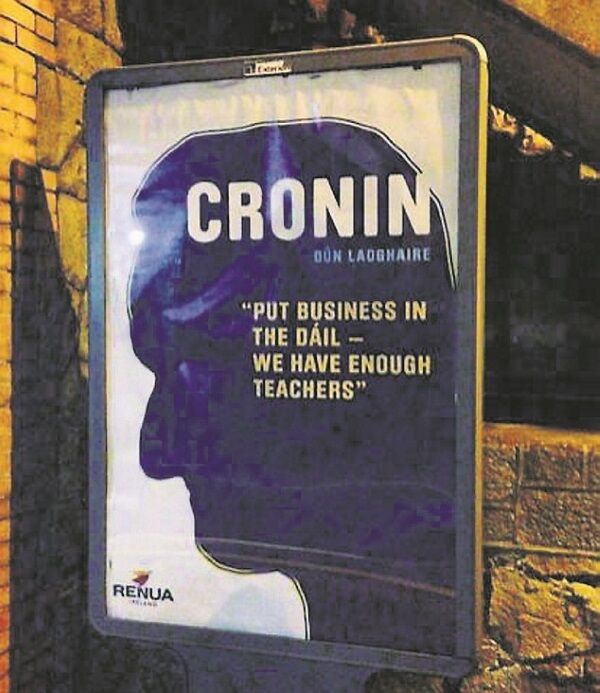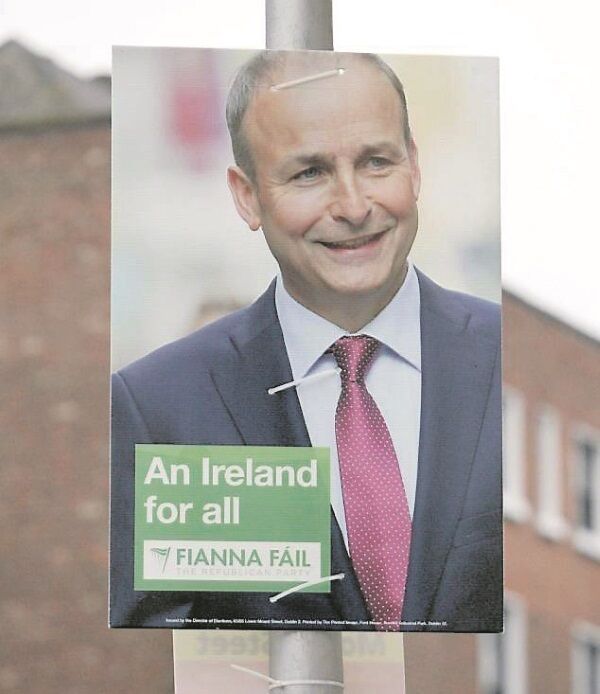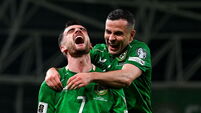Candidates use election posters to choose which face to present to the world

THERE, large as life, was Alfred Hitchcock, his head in characteristic silhouette filling up most of the billboard space. Could the Master of Suspense really be standing for election to the 32nd Dáil? What else was a floating voter to think?
From a distance, it was impossible to make out his election slogan, but it must surely be something like: “Give them what they want — a fright.”
Close, but no cigar.
In fact, the head in profile belonged to Renua candidate Frank Cronin and his slogan read: “Put business in the Dáil — we have enough teachers.”

When asked to explain the message behind the Hitchcockian poster campaign, he replied with a light, humorous touch: “Enjoy a thriller.” And, to be fair to the man standing in Dun Laoghaire’s four-seater, his poster is one of the very few with any sense of wit, imagination or mystery in the sea of wallpaper now plastered on every post and pillar in pre-election Ireland.
Many have justifiably called for a ban on election posters including, ironically enough, Cronin himself — but what a terrible loss that would be.
True, the arguments against them are solid. Frank Cronin says he would not have produced any posters if other candidates had agreed to do likewise. He says he’d prefer to see the money spent — an estimated €5,000 per candidate — go on better causes such as social housing.
It’s hard, too, to disagree with those who say they are an eyesore, a pollutant, even dangerous, as drivers say they can obscure the road.
But what about all that election posters reveal? They give us an unrivalled insight into the mind of the candidate, disclosing how they see themselves and, in turn, how they want us to see them. One candidate is using a picture from 2007 on his election posters.
Others have taken the miracles of Photoshop and used them to iron out the rough spots. A little well-placed vanity is hardly a sin but it does become an issue when the poster persona and the real person don’t look even like distant cousins.
It’s fascinating to study how the shots are framed, too. A picture taken from below can make its subject appear to be on higher ground than us mere mortals: “Look at me, I am here to lead.” Or maybe they are staking a claim to the moral high ground.
Though the angle has to be just so —you don’t want to show too much flaring nostril as that comes across as condescending.
Micheál Martin’s portrait of softly-lit carefree confidence gets the angle just right, though it’s hard to ignore the fact that he is missing a sliver from the top of his head. His supporters might see that as proof that Martin needs only a portion of his brain power to run the country, while the detractors might get in a dig about a receding hairline or worse.

Who knows how people will interpret what is put in front of them? What we can say with certainty is that any poster image is consciously chosen to give us a particular idea of who the candidate is and what they stand for.
Don’t think the people standing for election don’t think about this. The wonder is that we don’t talk about it more. It’s not as if spin and the image myth-making machine are anything new.
In 1957, critic Roland Barthes offered a penetrating analysis of popular culture’s most potent symbols in his ground-booking book, Mythologies. In one of its essays, ‘Photography and Electoral Appeal’, he said that the political propaganda transmitted through the electoral photograph was designed to ‘bait’ the viewer into seeing the subject in a particular way.
“Always interrogate the falsely obvious, the what-goes-without-saying,” he wrote.
That’s a very familiar message today, particularly to those canny users — and abusers — of social media.
What is remarkable in this election, though, is that the photograph’s persuasive power seems to have been completely forgotten. What were Fine Gael thinking? The current poster of leader Enda replaced an earlier version reportedly described by one party member as the Shroud of Turin.
The new version is little better. Kenny is so pallid, it looks as if he stepped out of the waxworks. Even the most committed Fine Gaeler would be challenged to read a positive message in that.
In this age of selfies and Instagram, the average voter has become an incisive decrypter of the sales image, though there are few codes to crack in the lacklustre offerings of 2016.

Veteran election-poster collector Alan Kinsella thinks posters started to become much more corporate – and bland — since the last election in 2011.
‘Promises, Promises... Political Ephemera’, an exhibition featuring some of his vast collection, opened at the Kenny Gallery in Galway this week. Its content makes you wonder where the rousing slogans of yore went to — from Fianna Fáil’s “Speed the Plough” in 1938, through to the clever 2007 formulation: “A Lot Done, More to Do.”
Fine Gael’s Alan Shatter made ripples in 1997 when he dressed up as Captain Kirk alongside a shot of William Shatner and told voters: “Only one of these men needs your number one vote.”
This time round, his posters are more po-faced but he’s still distributing bouncy balls emblazoned with the slogan “Shatter is on the ball”, something he’s done since the 1980s.
There are signs of other bursts of creativity too, particularly among the independents.
Mick Wallace has a lively series of posters which — and he should take this as a compliment — have inspired some witty vandals.
One saboteur has tied a real tie around Wallace’s neck on a poster proudly announcing “No ties”.
Indeed, it’s the cynical, poster-altering public that is proving more adept at manipulating the message in this election. And they have the technical edge. Forget the scribbled ’taches and Magoo glasses (though there are a few), one, let’s say doodling commentator, has produced a mash-up of the FF leader and Lord Voldemort along with the caption: “Obliviate.”
Scary. Maybe it’s all quite Hitchcockian after all.












